Compliance with the rules of operation of the dishwasher will extend its service life and achieve perfect cleanliness of the dishes. Many consumers do not heed such advice, which is why their equipment suffers and often breaks down. In this review, we will tell you how to use the dishwasher and what you need to pay attention to when performing certain operations. Strict adherence to the recommendations and rules will allow you to enjoy clean dishes every day.
What you need to know before using
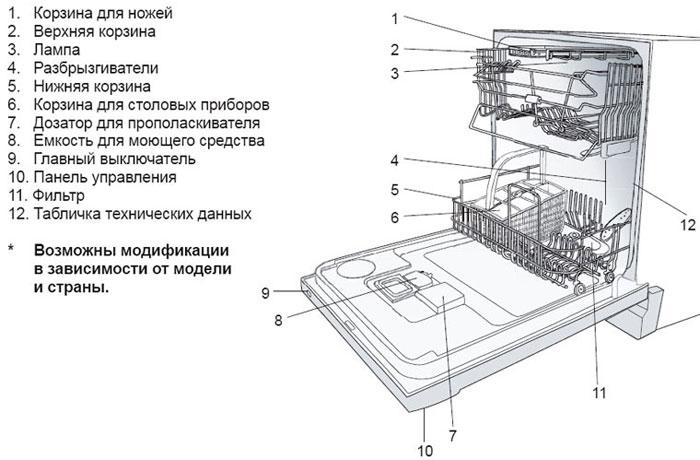
In order to learn how to use a dishwasher, you need to pick up the instructions and carefully read all of its points, tips and recommendations. The problem is complicated by the fact that in our country it is customary to read operating instructions only when “nothing works” - this is the mentality of domestic users who love to reach everything with their own mind.
Before using the dishwasher, it is necessary to learn the purpose of some of its nodes:
- Loading door - opens when you pull it towards you. In some models, during operation, it is blocked, you should not pull it and try to see what is happening in the working chamber;
- A working chamber with baskets - this is where dirty dishes are placed (we will tell you how to stack them correctly);
- Rocker arms - spinning gizmos with holes through which water and detergent beats. It is they who carry out the washing;
- Control panel - located on the front side of the dishwasher or on the end of its door. Here programs are selected, certain options are activated, settings are made;
- Backfill compartment special salt - located in the working chamber.The filter is also located there;
- Dispensers for detergent (tablets) and rinse aid - most often located in the door (sometimes in other places).
Also inside are an engine (it makes the water circulate), a control board (controls all electronics) and a drain pump - it removes dirty water into the sewer.
Many users do not know how to use the dishwasher, so they assume that it can be used immediately after purchase. But this is not entirely true, because we need to carry out two whole operations:
- Perform dishwasher installation;
- Carry out a test wash.
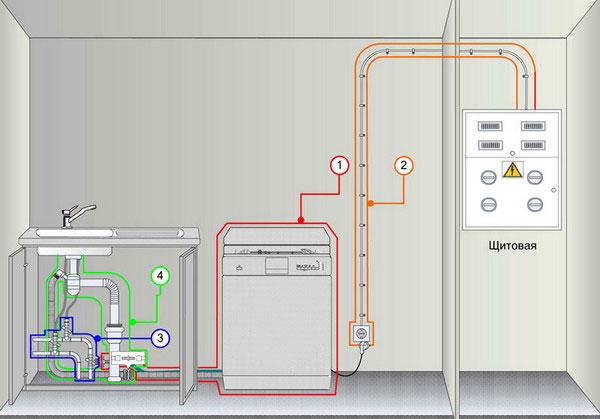
The installation of the dishwasher can be carried out independently or by a specialist. However, there is nothing complicated in this procedure:
- We install it in a regular place, depending on the type of machine (built-in or freestanding);
- We connect to the water supply with cold or hot water using an inlet hose (through a tee, manifold or bandage);
- We connect to the sewer through a special siphon or through an “oblique” tee (do not forget about the bends so that odors and water from the sewer do not get into the dishwasher);
- We connect to the mains through a regular outlet.
If there is no outlet nearby, we install a new one and supplement it with an RCD circuit breaker.
We continue to figure out how to use the dishwasher - we move on to the idle wash stage. The thing is that it is impossible to use it immediately after installation, since dirt, dust and residues of engine oil used to lubricate individual components could remain in its insides. That's why before use, you need to carry out a blank wash - it is made using washing powder, but without rinse aid (you can pour a little water into this dispenser).
Next, we launch some program with a maximum temperature - look at the passport of your device and select the appropriate mode. We leave the dishwasher alone and go about our business. As soon as she completes the cycle and drains the water into the sewer, the device can be used.
How to properly load dishes in the dishwasher
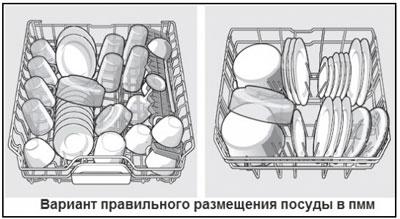
Let's take a look at how to properly use a dishwasher in real-life conditions.At the first stage, we are waiting for a serious test - this is loading dirty dishes into the working chamber. Her do not pile on a slide, as in this case only the lowest objects will be washed. The rocker arms in dishwashers are located at the bottom, so the dishes should be positioned so that water and detergent can reach each cup or saucer.
If you are just learning how to use a dishwasher, here are some tips for you:
- Place the plates only vertically, do not stack them on top of each other - due to the fact that the jets hit from the bottom up, only the bottom plate will be washed normally;
- Try not to use any non-standard dishes (for example, tureen cups take up more space than standard plates for first courses);
- Follow the recommendations on the possibility of machine washing of certain kitchen utensils;
- Try to use the "delicate" program when washing expensive crystal, thin wine glasses and other fragile items.
But that's not all - ahead of us is a test for the maximum laying of dishes.
Manufacturers are trying to make for us, consumers, the most convenient baskets for laying kitchen utensils. Some of them have an adaptable design, they use moving elements. It is also possible to adjust the baskets in height - all this is necessary for more convenient loading.
Many of us are familiar with the once popular Tetris game, when it was necessary to lay motley figures so that even lines were formed, without holes. Putting plates, cups and saucers into the dishwasher is somewhat reminiscent of this game - not everyone can lay the maximum number of utensils the first time.Therefore, this procedure will have to suffer.
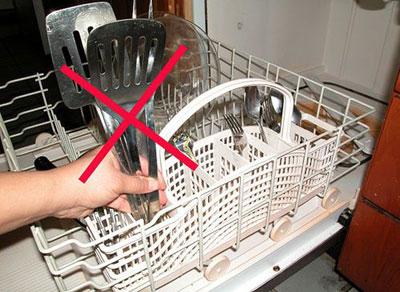
When learning how to use a dishwasher, you can get tips on a convenient bookmark in the following sources:
- On the Internet - many housewives and owners of dishwashers willingly share their secrets;
- The brochure that came with your dishwasher tells you how to use the baskets. Also there is often diagrams are given for the location of objects;
- Friends and girlfriends - perhaps someone already has a dishwasher, and this person has already passed the stage where he learned how to use a dishwasher.
But the easiest way is to look at the instructions, which describe exemplary schemes.
Most of the difficulties await people who have at their disposal narrow dishwashers. They have narrow working chambers and equally narrow baskets - this is where you really need to suffer in order to load the maximum of plates, cups, bowls and other things. As for the owners of full-size devices, they expect less torment - whatever you say, but there really is more space here.
How to add detergent
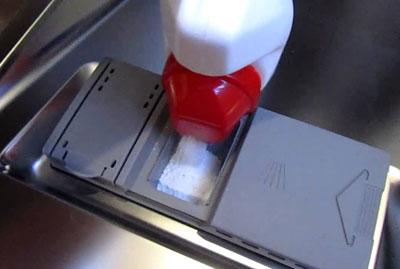
Now you know how to properly use the dishwasher and put in it what needs to be washed. Moving on, we need to learn how to use dispensers and run programs. Poroshock for dishwashers is loaded into a special dispenser - no need to fill it in the working chamber or somewhere else. If you do not know where the powder filling compartment is located, look at the instructions.
Next, fill conditioner - a special compartment is allocated for it.Unlike powder, which must be poured before each cycle, rinse aid is poured once and for a long time. As a rule, its consumption is set by the user independently, in the process of setting up the dishwasher. In the future, he climbs out of here during the final rinse. If the product is finished, the dishwasher will light the corresponding indicator.
Salt is placed in a special compartment located at the bottom of the working chamber. We unscrew the plastic cover, insert a special watering can and add about 1 kg of salt - it will last for a long time. After that, we test the hardness of the water and set the resulting parameter in the settings of the dishwasher. Here's everything you need to know about planting chemicals when you're learning how to use smart kitchen appliances.
Washing in the dishwasher
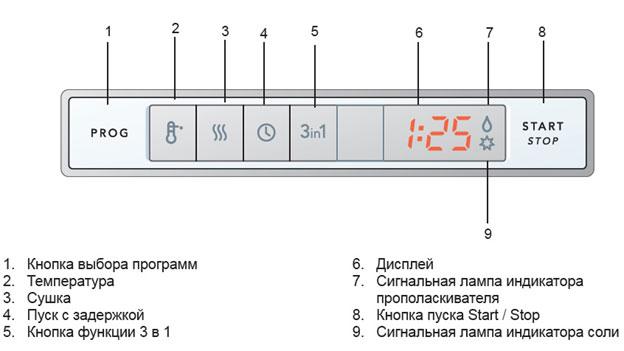
We are learning to use the dishwasher further - after falling asleep / pouring chemistry and laying the dishes, you must select the program. For the first time, try using different modes to find the one that suits you best in terms of quality and duration. Also we recommend trying to wash heavily soiled dishes in a special intensive mode - so you can evaluate the capabilities of the device.
No need to look into the cooking chamber while washing dishes. You can be burned by steam or doused with hot water. In addition, many dishwashers simply will not allow you to open the door on the go. So you just have to wait.At the end of the wash, the machine will give some kind of signal about the end of the cycle - using a beam on the floor, LED indicators or an audible alarm.
Dishwasher Tips

So we learned how to use such kitchen appliances as a dishwasher. Finally, here are some helpful tips:
- Do not try to use "homemade" detergents – this may damage the dishwasher;
- Try to use proven chemistry from the middle and highest price categories - cheap pills and powders may not give the most positive results;
- Do not wash dishes that are not intended for machine washing in dishwashers;
- Try to wash large items with your hands (pots, pans) - this way you will save time and space for smaller items;
- Remove large, dried and burnt dirt manually - the dishwasher can not cope with them;
- We recommend using cleaners once a month - they help to clean the working chamber and other components from grease, lime deposits and other dirt;
- Remember to clean the filter periodically.
By learning how to properly use your dishwasher, you can extend its life and get your dishes creaking from cleanliness.
